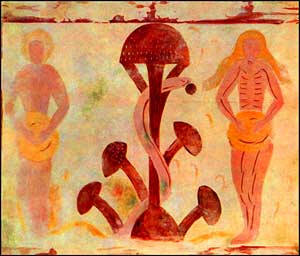
Adam and Eve
Symbols
[The Snake
(Devil/Satan/Lucifer) was Enki (symbol
Caduceus), so it would be expected the snake
around the tree looks just like an Asclepius
staff, as the paintings points show, which must be why some of the staffs
look like small trees.
Earth by one account was the garden of people from the planet
Eden, such is it's beauty (similar to Avatar
planet), and it still is Paradise/Eden, something you can see if you are in the
right place and in Satori.
Don Juan said the story
was an allegory for when our Assemblage point
was moved from the point of 'knowledge' to the point of 'reason', so the true
story is more like the snakes moved our assemblage points (maybe to do with the
Kali Yuga), to take away our
spiritual knowledge, and stopped the natural rise of kundalini energy through
Ida and Pingali, hence the two snakes seen in some Orthodox
Church
Religious staffs (see
Caduceus), in
Allopathy Inc symbol, and the symbol
of satanic 'gods', the Annunaki (Osiris,
Enki, Ishtar, Hermes,
Quetzalcoatl
& Ningishzidda).
These are the three Churches (Religion, Medicine,
Satanism) that have suppressed our
spirituality and make us 'aware of our nakedness' through
Suppressing sexuality, as there
are tribes walking the planet now outside of their influence who walk around
naked or mostly naked, without any feelings of shame, and are very spiritual.
We were actually at one with the tree of knowledge,
before, so the truth is the exact opposite. Another name for the point of
knowledge would be Wisdom. If you are on the point of knowledge you have
access to Universal knowledge, can 'talk to Jesus', to use
Shaman Quanah Parker's
term, and you also know you live forever, you are not your body, hence you have
no need for religion.]
Quotes
Paintings, logos
Tree of
knowledge
The Garden of
the Hesperides
Asclepius
Eve, the Serpent and Death
[vid] Michael Tellinger's presentation of the annunaki and more! MUST WATCH!
Article
[2012] New (Reptilian) World Order By
Uri Dowbenko
Quotes
A common misinterpretation of the Adam and Eve story is that the "original sin"
had something to do with sex or nudity. This confusion comes from that part of
the story in which Adam and Eve eat from the "tree of knowledge of good and
evil" and immediately become ashamed of their nakedness. It was not nudity,
however, that shamed them.
Adam and Eve were mortified by what their nakedness re
presented. Ancient Mesopotamian records depict human beings stark naked when
performing tasks for their Custodial masters. Custodians, on the other hand,
were depicted as being fully clothed. The implication is that Adam and Eve felt
degraded by their nakedness because it was a sign of their enslavement—not
because being naked in itself is bad..
.......The ancient version is that an extraterrestrial society had come to
possess Earth and sought to exploit the planet's resources. To make the
exploitation easier, a work race was created: Homo sapiens. Humans were treated
as livestock and were frequently butchered when they became too numerous or
troublesome. To preserve Homo sapiens as a slave race and to prevent future
rebellion, spiritual knowledge was repressed, human beings were scattered
geographically into different linguistic groups, and conditions were created to
make physical survival on Earth an all-consuming chore from birth until death.
This arrangement was to be maintained indefinitely for as long as the Custodial
society possessed Earth. In contrast, the modern view is that human beings had
evolved accidentally from "star stuff" into slime, into fishes, into monkeys,
and finally into people. The modern view actually seems more fanciful than the
ancient one.
In the story of Adam and Eve we noted the appearance of a
snake. The serpent was said to be "God's" enemy, Satan, who had literally
transformed himself into a reptile. The Bible suggests that snakes are feared
and disliked today because of Satan's alleged transformation back in the Garden
of Eden. However, it should be remembered that the Biblical Adam and Eve story
is entirely symbolic. The snake, too, was a symbol, not an actual reptile. To
determine what the Biblical snake represented, we must go back once again to
older pre-Biblical sources.
When we do so, we discover that the snake symbol had two
very important meanings in the ancient world: it was associated with the
Custodial "god" Ea, reputed creator and benefactor of mankind, and it also
represented an influential organization with which Ea was associated.
[1989] Gods of Eden by William Bramley
In the Book of Genesis, the tree of the knowledge of good and evil or the tree of knowledge (occasionally, the tree of conscience) was a tree in the middle of the Garden of Eden. (Genesis 2:9). God directly forbade Adam (Eve having not yet been created) to eat the fruit of this tree. A serpent tempted Eve, who was aware of the prohibition against eating the forbidden fruit of the tree of knowledge (Genesis 3:1-6). The serpent had suggested to Eve that eating the fruit would bestow wisdom upon them. Eve and then Adam ate the forbidden fruit, and they became aware of their nakedness (Genesis 3:6-7). wikipedia
When you begin to look back, you realize the early Christian, from the time
of Jesus to the time of Constantine in 310 AD, they were preaching that they did
not worship Jehovah; they worshiped the one true God. It could be argued
that the early Christians were actually Gnostic followers of Jesus instead of
what we, today, call Christians. The entire New Testament was completely
rewritten by Constantine and all of the information on the Archons was removed
and the ideas of Jehovah being a cruel god were lessened. This is a fact. The
Nag Hammadi texts are older than the New Testament by 400 years. The New
Testament that we have today wasn’t concocted until about 350 AD. When you go
back to the Nag Hammadi, it doesn’t have the sin factor; they say what they
really think.
....They are against gnosis, they are against knowledge. The defining myth of
Western mythology is that Jehovah told Adam and Eve that they could not
eat of the Tree of Knowledge. Not only that but if they did eat of it, they
would surely die. Yet they both ate of it and didn’t die so he wasn’t even
telling them the truth. Rise of the Archons An interview with Jay Weidner on Rense Radio
The Qur'an doesn't name this tree and it is always referred to as "the tree". Muslims believe that when God created Adam and Eve, He told them that they could enjoy everything in the Garden but this tree, and so, Satan appeared to them and told them that the only reason God forbade them to eat from that tree is that they would become Angels or become immortals. When they ate from this tree their nakedness appeared to them and they began to sew together, for their covering, leaves from the Garden. As a result of their sin, they were removed from heaven and placed on Earth to live and die. Consequently, they repented to God and asked for his forgiveness and were forgiven. It was decided that those who obey God and follow his path shall be rewarded with everlasting life in Heaven, and those who disobey God and stray away from his path shall be punished in Hell. wikipedia
In Greek mythology, the Hesperides are nymphs who tend a blissful garden. Ordinarily the Hesperides number three, like the other Greek triads (the Three Graces and the Moirae). "Since the Hesperides themselves are mere symbols of the gifts the apples embody, they cannot be actors in a human drama. Their abstract, interchangeable names are a symptom of their impersonality,"...........The Garden of the Hesperides is Hera's orchard in the west, where either a single tree or a grove of immortality-giving golden apples grew. The apples were planted from the fruited branches that Gaia gave to her as a wedding gift when Hera accepted Zeus. The Hesperides were given the task of tending to the grove, but occasionally plucked from it themselves. Not trusting them, Hera also placed in the garden a never-sleeping, hundred-headed dragon named Ladon as an additional safeguard. http://en.wikipedia.org/wiki/Hesperides
The question arises as to how Christian philosophy and theology, which borrowed heavily from Aristotle, managed to avoid, if not outright reject, Aristotle's teachings regarding the morality of pleasure. The roots to this question can be found throughout the Old Testament, beginning with the account in Genesis of the expulsion of Adam and Eve from the Garden of Eden. The first consequence of Eve's transgression was that nudity became shameful. This even may well be the beginning of man's hostility toward women and the equating of woman with evil, particularly the evils of the body. This is vividly portrayed in Zechariah (5:5-8) in an angel's description of the flying bushel: "This is a bushel container coming. This is their guilt in all the land." Then a leaden cover was lifted and there was a woman sitting inside the bushel. "This is wickedness, he said, and he thrust her inside the bushel, pushing the leaden cover into the opening."[1975] BODY PLEASURE AND THE ORIGINS OF VIOLENCE By James W. Prescott

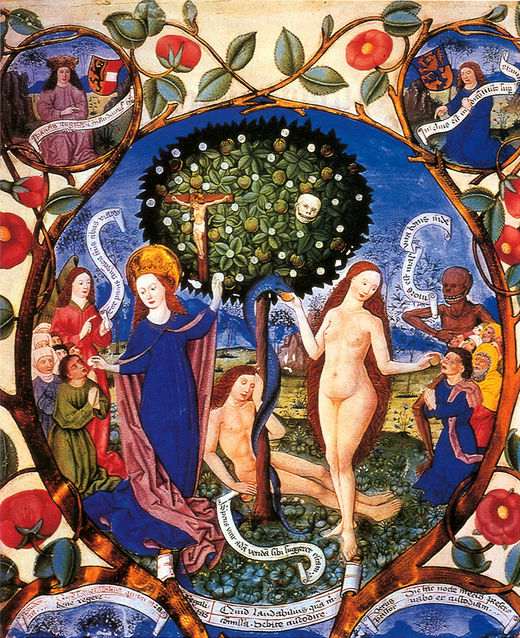
A miniature painting of the Baum des Todes und des Lebens (The Tree of Death and
Life), by Bertold Furtmeyer for the Missal of Archbishop Bernard von Rohr of
Salzburg, a handmade miniature manuscirpt commissioned by him around 1481 and
now in the Museum of the Bavarian State Library (Bayerische Staatsbibliothek),
Munich, Germany.
http://www.ancientworlds.net/aw/Post/1189591
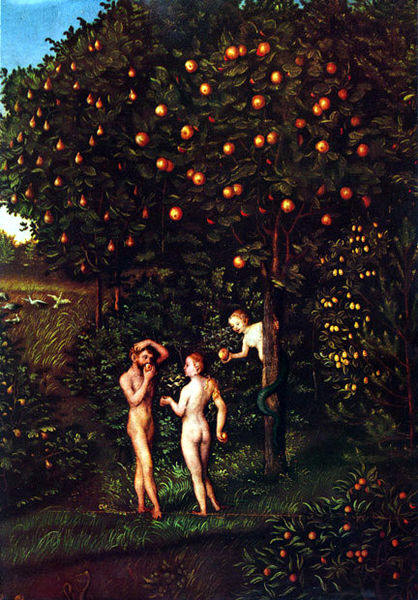
The Tree of Knowledge, painting by Lucas Cranach the Elder
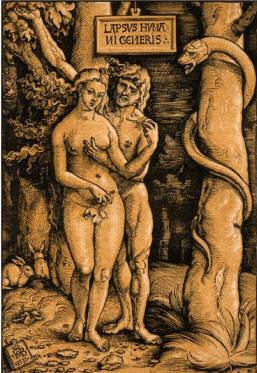
Snake here looks like
Asclepius staff.
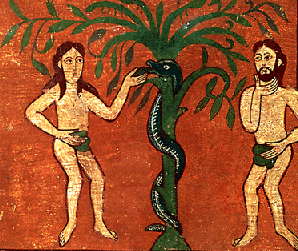
Adam and Eve painting
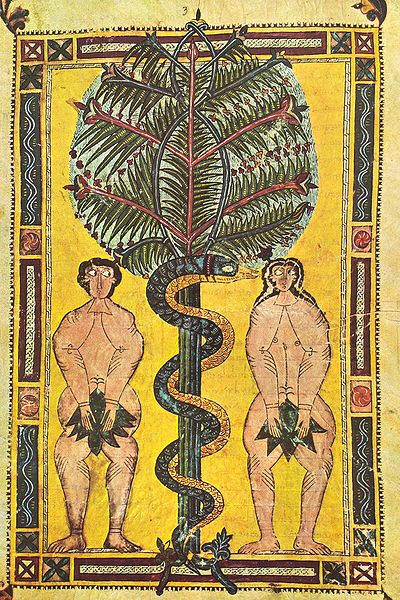
Adam & Eve, illuminated manuscript circa 950, Escorial Beatus
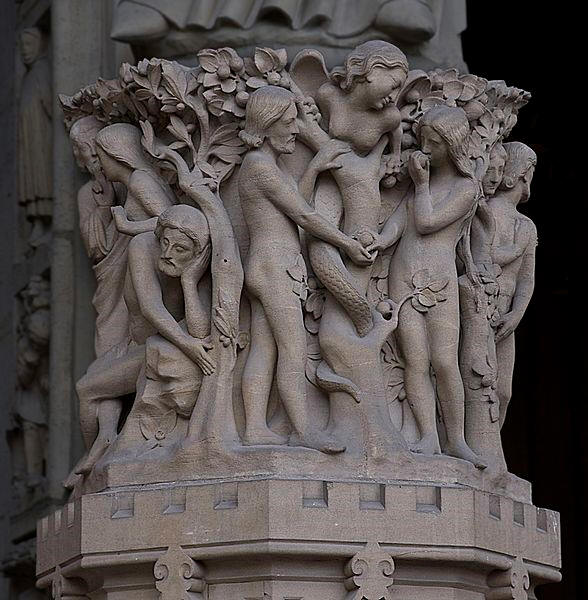
Adam, Eve, and the (female) Serpent (often identified as Lilith) at the entrance
to Notre Dame Cathedral in Paris. Medieval Christian art often depicted the
Edenic Serpent as a woman, thus both emphasizing the Serpent's seductiveness as
well as its relationship to Eve. Several early Church Fathers, including Clement
of Alexandria and Eusebius of Caesarea, interpreted the Hebrew "Heva" as not
only the name of Eve, but in its aspirated form as "female serpent."
http://en.wikipedia.org/wiki/Adam_and_Eve
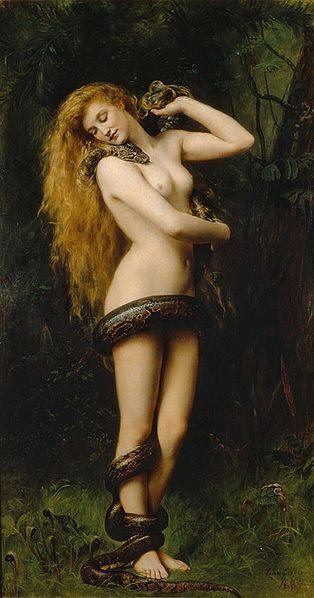
Lilith (with Satan the serpent), painting by John Collier (1892)
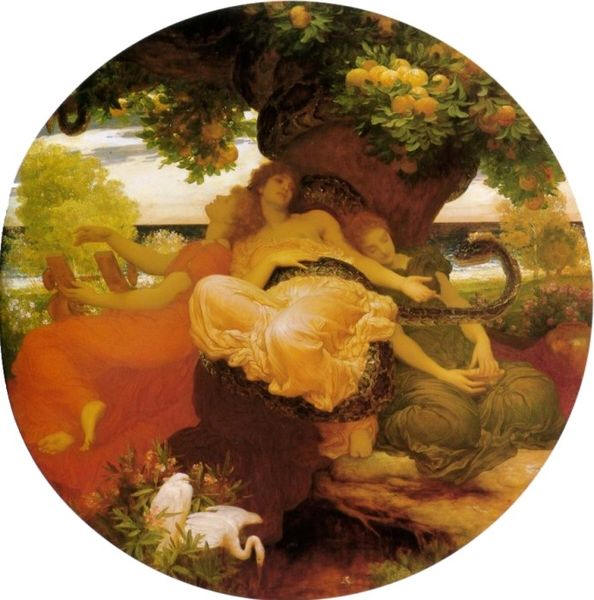
The Garden of the Hesperides by Frederick, Lord Leighton, 1892.
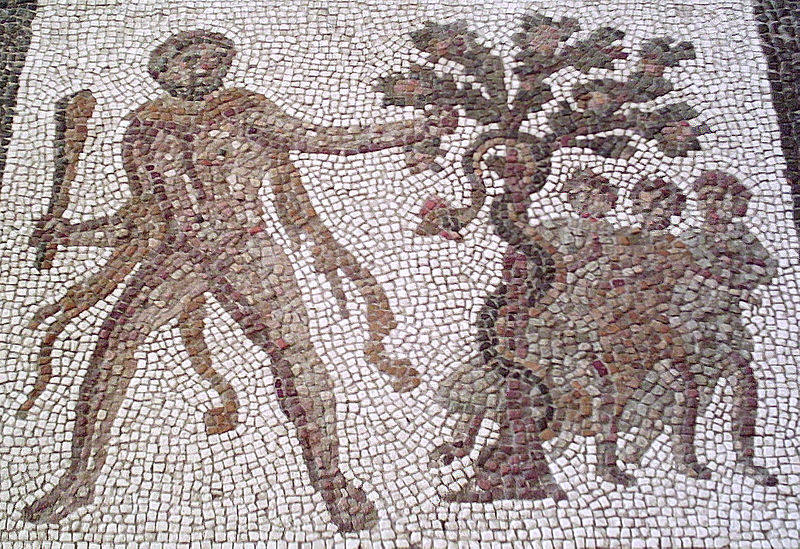
Hercules stealing the golden apples from the Garden of the Hesperides. Detail of
a Twelve Labours Roman mosaic from Llíria, Spain (3rd century).
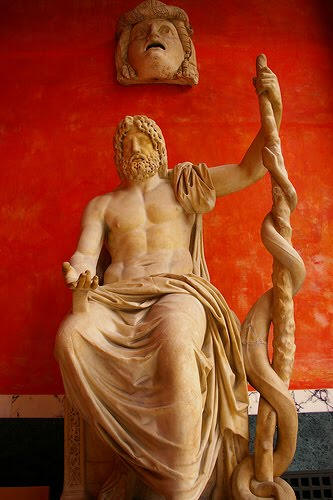
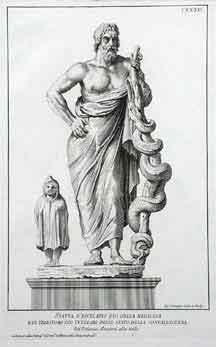
Asclepius
(more small tree than staff)
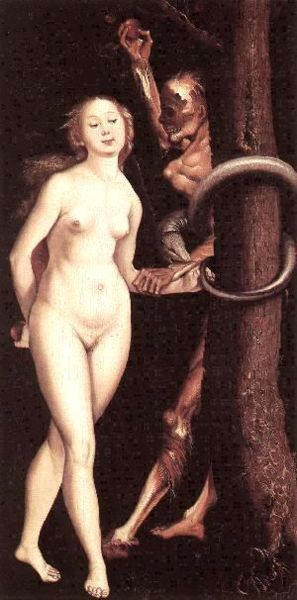
The main elements are intertwined; the serpent is coiled around the tree trunk
and also around Death, who he holds to the tree. Death's right arm extends
upward to grasp the apple. The serpent, which has red eyes and a weasel-like
head, closes its jaws around the wrist of Death's left arm, which is at the same
time grasping the left arm of Eve. Eve's left hand holds part of the serpent's
tail, while her right hand holds an apple behind her back. Among Baldung's
treatments of the Fall, the new element in Eve, the Serpent and Death is the
active role of the snake; Adam's decrepit condition, halfway between nude and
skeleton, suggests the work of poison, as if from the serpent, and the snake's
grip on Adam recalls the biting of the apple in the Fall. The apple that each of
the figures holds is the symbolic origin of the present scene, in which
"everything is dependent on and implicated in everything else" (Koerner, 310).
http://en.wikipedia.org/wiki/Eve,_the_Serpent_and_Death